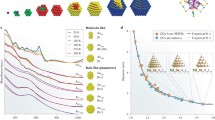Abstract
Colloidal synthesis of metal nanocrystals often relies on using reduction kinetics to manipulate their size, shape, internal structure and composition. Whereas the first three features can all be readily manipulated, it remains challenging to control the composition of nanocrystals because the reduction rate, and thus the production rate of atoms, follows an exponential decay during the synthesis. By stabilizing the reduction rate of a precursor in the steady state, dropwise addition has emerged as a transformative route for the colloidal synthesis of nanocrystals. This Perspective highlights the advantages of dropwise addition over traditional one-shot injection for controlling the composition and elemental distribution of bi- and multi-metallic nanocrystals. Our analysis demonstrates the promise of dropwise addition for achieving the deterministic synthesis of complex nanocrystals with controlled compositions for a range of applications, especially those related to catalysis and energy conversion.





Similar content being viewed by others
References
Pearce, A. K., Wilks, T. R., Arno, M. C. & O’Reilly, R. K. Synthesis and applications of anisotropic nanoparticles with precisely defined dimensions. Nat. Rev. Chem. 5, 21–45 (2021).
Chen, R., Lyu, Z., Shi, Y. & Xia, Y. Improving the purity and uniformity of Pd and Pt nanocrystals by decoupling growth from nucleation in a flow reactor. Chem. Mater. 33, 3791–3801 (2021).
Zheng, Y., Zhong, X., Li, Z. & Xia, Y. Successive, seed-mediated growth for the synthesis of single-crystal gold nanospheres with uniform diameters controlled in the range of 5–150 nm. Part. Part. Syst. Charact. 26, 13890–13895 (2020).
Shi, Y. et al. Noble-metal nanocrystals with controlled shapes for catalytic and electrocatalytic applications. Chem. Rev. 121, 649–735 (2021).
Bin, D. S. et al. Controlling the compositional chemistry in single nanoparticles for functional hollow carbon nanospheres. J. Am. Chem. Soc. 139, 13492–13498 (2017).
Link, S., Wang, Z. & El-Sayed, M. A. Alloy formation of gold–silver nanoparticles and the dependence of the plasmon absorption on their composition. J. Phys. Chem. B 103, 3529–3533 (1999).
Stamenkovic, V. R. et al. Improved oxygen reduction activity on Pt3Ni(111) via increased surface site availability. Science 315, 493–497 (2007).
Yao, Y. et al. Carbothermal shock synthesis of high-entropy-alloy nanoparticles. Science 359, 1389–1394 (2018).
Tong, K. et al. Structural transition and migration of incoherent twin boundary in diamond. Nature 626, 79–85 (2024).
Swallow, J. E. N. et al. Revealing the role of CO during CO2 hydrogenation on Cu surfaces with in situ soft X-ray spectroscopy. J. Am. Chem. Soc. 145, 6730–6740 (2023).
Fan, L. et al. High entropy alloy electrocatalytic electrode toward alkaline glycerol valorization coupling with acidic hydrogen production. J. Am. Chem. Soc. 144, 7224–7235 (2022).
Lamer, V. K. & Dinegar, R. H. Theory, production and mechanism of formation of monodispersed hydrosols. J. Am. Chem. Soc. 72, 4847–4854 (1950).
Corbett, J. F. Pseudo first-order kinetics. J. Chem. Educ. 49, 663 (1972).
Wang, C. et al. Facet-controlled synthesis of platinum-group-metal quaternary alloys: the case of nanocubes and {100} facets. J. Am. Chem. Soc. 145, 2553–2560 (2023).
Peng, H. C., Park, J., Zhang, L. & Xia, Y. Toward a quantitative understanding of symmetry reduction involved in the seed-mediated growth of Pd nanocrystals. J. Am. Chem. Soc. 137, 6643–6652 (2015).
Zhang, D. et al. Dropwise addition of cation solution: an approach for growing high-quality upconversion nanoparticles. J. Colloid. Interface Sci. 512, 141–150 (2018).
Nguyen, Q. N., Wang, C., Shang, Y., Janssen, A. & Xia, Y. Colloidal synthesis of metal nanocrystals: from asymmetrical growth to symmetry breaking. Chem. Rev. 123, 3693–3760 (2023).
Zhou, M. et al. Quantitative analysis of the reduction kinetics responsible for the one-pot synthesis of Pd–Pt bimetallic nanocrystals with different structures. J. Am. Chem. Soc. 138, 12263–12270 (2016).
George, E. P., Raabe, D. & Ritchie, R. O. High-entropy alloys. Nat. Rev. Mater. 4, 515–534 (2019).
Li, K. & Chen, W. Recent progress in high-entropy alloys for catalysts: synthesis, applications, and prospects. Mater. Today Energy 20, 100639 (2021).
Xin, Y. et al. High-entropy alloys as a platform for catalysis: progress, challenges, and opportunities. ACS Catal. 10, 11280–11306 (2020).
Zhao, M. & Xia, Y. Crystal-phase and surface-structure engineering of ruthenium nanocrystals. Nat. Rev. Mater. 5, 440–459 (2020).
Chen, P. C. et al. Polyelemental nanoparticle libraries. Science 352, 1565–1569 (2016).
Acknowledgements
This work was supported in part by a research grant (DMR 2333595) from the NSF and start-up funds from the Georgia Institute of Technology. We are grateful to our co-workers and collaborators for their invaluable contributions to this project.
Author information
Authors and Affiliations
Contributions
This Perspective was conceived by Y.X. and was written by C.W., J.H. and Y.X.
Corresponding author
Ethics declarations
Competing interests
The authors declare no competing interests.
Peer review
Peer review information
Nature Synthesis thanks Xuelian Chen and Svetlana Neretina for their contribution to the peer review of this work. Primary Handling Editor: Alexandra Groves, in collaboration with the Nature Synthesis team.
Additional information
Publisher’s note Springer Nature remains neutral with regard to jurisdictional claims in published maps and institutional affiliations.
Rights and permissions
Springer Nature or its licensor (e.g. a society or other partner) holds exclusive rights to this article under a publishing agreement with the author(s) or other rightsholder(s); author self-archiving of the accepted manuscript version of this article is solely governed by the terms of such publishing agreement and applicable law.
About this article
Cite this article
Wang, C., He, J. & Xia, Y. Controlling the composition and elemental distribution of bi- and multi-metallic nanocrystals via dropwise addition. Nat. Synth 3, 1076–1082 (2024). https://doi.org/10.1038/s44160-024-00600-x
Received:
Accepted:
Published:
Issue Date:
DOI: https://doi.org/10.1038/s44160-024-00600-x
- Springer Nature Limited





